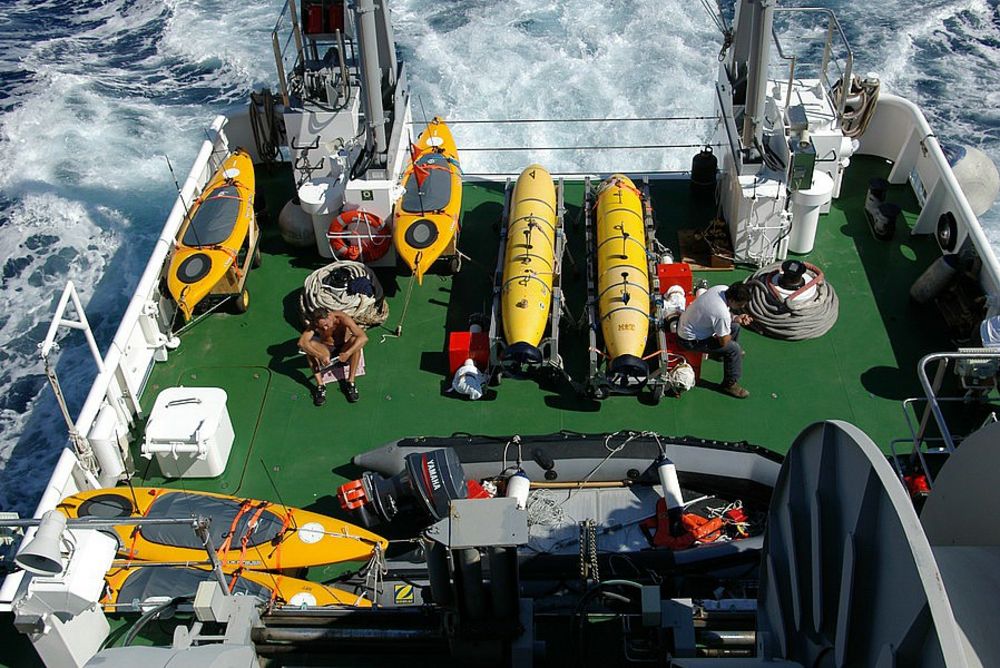
Bluefin'21 AUVs and autonomous surface crafts operated by the MIT Laboratory for Autonomous
Marine Sensing from the NATO R/V Leonardo in July 2005 at Elba Island, Italy.

The MIT Laboratory for Autonomous Marine Sensing in the Department of Mechanical Engineering is specializing in the development of new distributed ocean sensing concepts for oceanographic science, national defense and coastal management and protection. The laboratory was established in 2005 following the merger of the Mechanical and Ocean Engineering departments. It continues two decades of multi-disciplinary research and development into such systems by Department of Ocean Engineering, and the MIT Sea Grant AUV Laboratory. In addition to the Laboratory Director, Prof. Henrik Schmidt, four faculty, Prof. John Leonard, Prof. Daniela Rus, Prof. Arthur Baggeroer, and Prof. Pierre Lermusiaux, and three Research Engineers, Dr. Arjuna Balasuriya, Mr. Joseph Curcio and Dr. Michael Benjamin. The faculty and staff, together with a significant number of students and post-doctoral associates provides a strongly multidisciplinary team with expertise in oceanographic sensing and modeling, sonar system technology, computational underwater acoustics, and marine robotics and communication networking.
The Laboratory owns and operates two state-of-the-art Bluefin'21 autonomous underwater vehicles (AUV), and a fleet of ten autonomous surface craft (ASC), as well as support equipment for their operation, including an acoustic communication bouy, and a Sonadyne long baseline navigation system. The laboratory is operating the AUV and ASC from research vessels, and have been deployed and operated on average once a year during major field experiments. Through joint research agreements with the NATO Undersea Research Centre (NURC) in La Spezia, Italy, the Laboratory has regular access to their two research vessels, and their engineering research staff. The Laboratory operates several payloads for the AUV, including three acoustic sensing payloads for oceanographic mapping, bottom and sub-bottom object detection. Currently, a new payload is being built under ONR DURIP funding, including a highly capable acoustic towed array, intended for littoral undersea surveillance, and other underwater acoustic research.
The laboratory operates a cluster of ten workstations, in addition to a large number of laptop computers used for the field efforts. Most of the computers are operated using the Linux operating system, with the laptops in general having a dual-boot capability in Windows. The computer network includes a central CVS server for the open-source MOOS-IvP autonomous platform control software applied exclusively for the robotic platforms in the Laboratory. It also supports a state-of-the-art underwater acoustic modeling capability available to faculty, staff and students. A specific capability is a comprehensive MOOS-IvP simulation capability, which is used for simulation experiments, which the Laboratory uses extensively in the planning and preparation of field experiments, and for development and testing of new autonomous behaviors and processes. A unique capability of the MOOS-IvP simulator is the full integration of a high-fidelity, real-time underwater acoustic modeling capability, which supports simulation of fully autonomous acoustic sensing missions with AUVs towing hydrophone arrays. This capability is a crucial component of the development of the fully integrated, autonomous sensing, modeling and control concepts being required for distributed underwater surveillance systems with no or extremely limited possibility for operator involvement and intervention.

Through an agreement with the MIT Sailing Pavilion the Laboratory has established a test-bed for the autonomous surface craft on the Charles River, adjacent to MIT. This Charles River ASC Test-bed is used for smaller scale testing of new adaptive and collaborative sensing concepts. As such it provides a useful intermediate link between the simulation environment and ocean field experiments. The test-bed is used routinely for development and testing of collaborative and adaptive, autonomous control of up to ten ASC using the MOOS-IvP control architecture.
With Prof. Pierre Lermusiaux joining MIT in Jan. 2007, and becoming the latest faculty to be associated, the Laboratory will add the Harvard Ocean Prediction System (HOPS) to its in-house capabilities. The Laboratory faculty has a decade long history of collaborating with the HOPS group, and most recently, as part of the ONR PLUSNet effort, HOPS is being closely integrated with the MOOS-IvP simulation environment, further enhancing the Laboratory's capabilities for simulating adaptive and collaborative sensing missions with distributed, fixed and mobile platforms.